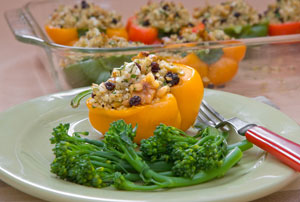 It’s walnut week here at Diets In Review. I’ve been blogging some great interviews with top fitness, culinary, and health experts on all things walnuts, and of course, healthy eating. If you’ve missed my posts, you can always catch up at our walnut week roundup page! Next up, an amazing interview with cookbook author Mollie Katzen. Read what she thinks you should eat to get healthy:
It’s walnut week here at Diets In Review. I’ve been blogging some great interviews with top fitness, culinary, and health experts on all things walnuts, and of course, healthy eating. If you’ve missed my posts, you can always catch up at our walnut week roundup page! Next up, an amazing interview with cookbook author Mollie Katzen. Read what she thinks you should eat to get healthy:
1. What trends or patterns do you see towards healthier menu options or healthier recipes?
I am happy to see that main portions of meat or fish are becoming smaller, and vegetable dishes are taking up more space on the plate. Also, I’ve been seeing a very encouraging trend toward more than one vegetable dish on the same plate – with complementary colors and flavors. Should menu options state that they’re healthy or smart choices? I don’t think so. I think this is a turn-off to customers, even those who intend to eat well. There is still an association with “healthy” and under-seasoned, uninteresting, prescriptive. I think we should all just let the customers fall in love with the healthy food on its own merits.
2. What are some techniques you follow when creating “smart” menu options?
I make sure to keep the flavors potent (upping the seasoning, if necessary) and I use vegetables (and sometimes fruit) to fill out the volume. I make things taste richer through the addition of good oils (olive oil, avocado, walnuts).
3. Walnuts offer a range of nutritional benefits, and are known for their 2.5g of omega-3s per serving, but it’s their versatility which makes them a unique ingredient to cook with. Will you share some of your favorite ways to use walnuts?
I use them most frequently as a topping for various dishes – both savory and sweet. I always toast them at a low temperature (about 250°F for 10 minutes or so) ahead of time to maximize their great flavor. I like to combine ground walnuts with whole grains for pilafs, with low-fat cheeses for dips, with roasted puréed vegetables for toppings, and with bread crumbs for superb crusts. These are just a few approaches – there are many!
4. Many experts simply tell consumers what NOT to eat, but what is really needed now is what are we replacing that with? What are your thoughts on this? As we move those things (sugars, saturated fats) off the plate, what do we replace them with and what do we move on the plate?
Vegetables, fruit, whole grains, and nuts, most particularly walnuts. There are very few people who eat the requisite number of fruit and vegetable servings daily, so there is a lot of room to add these into people’s diets. And there is a volume pay-off involved, as most vegetables and many kinds of fruit can be “unlimiteds” or “freebies” on people’s healthy eating plans. So in many cases, you can “go for it” without counting servings or measuring serving size. Of course this depends on how it’s prepared.
Enjoy walnut-inspired recipes from Molly and the California Walnut Board:
